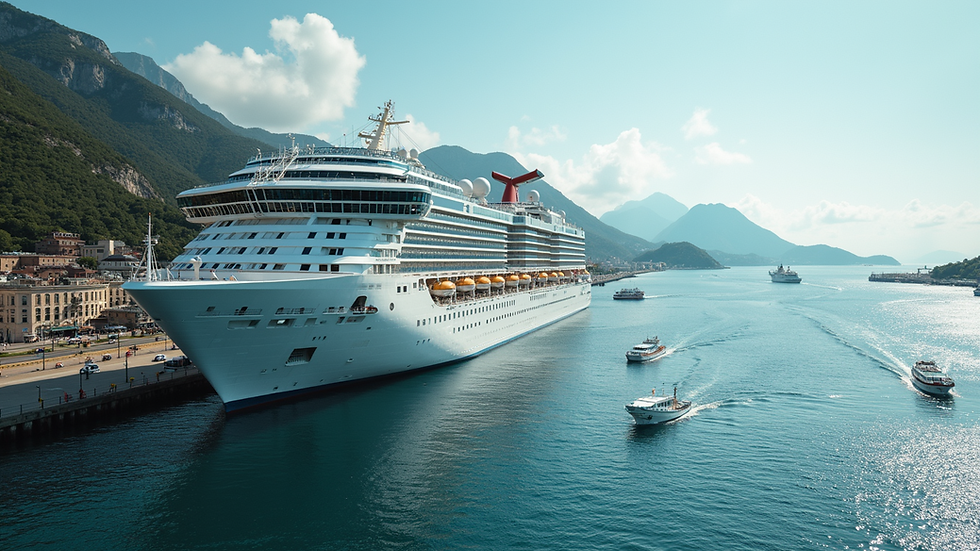The Importance of Collaboration in the Cruise Industry
- Elizaa Liza
- Sep 2
- 4 min read
The cruise industry is a dynamic and complex sector that thrives on cooperation and shared goals. Collaboration among cruise lines, ports, suppliers, and other stakeholders is essential to delivering exceptional experiences to passengers while maintaining operational efficiency. This article explores why cruise collaboration is vital, how it benefits the industry, and what it means for travelers seeking premium and sustainable cruise experiences.
Why Cruise Collaboration Matters
Collaboration in the cruise industry is more than just working together - it is about creating synergies that enhance every aspect of the cruise experience. When companies join forces, they can pool resources, share knowledge, and innovate faster. This leads to better service quality, improved safety standards, and more sustainable operations.
For example, cruise lines often collaborate with local ports to streamline embarkation and disembarkation processes. This reduces wait times and enhances passenger comfort. Additionally, partnerships with environmental organizations help cruise companies adopt greener technologies and reduce their carbon footprint.
Collaboration also allows cruise operators to offer diverse itineraries by sharing access to exclusive destinations. This benefits travelers by providing unique experiences that might not be possible through a single cruise line alone.

The Role of Cruise Collaboration in Enhancing Passenger Experience
Passenger satisfaction is at the heart of the cruise industry’s success. Cruise collaboration plays a crucial role in elevating the onboard and onshore experience. By working together, cruise lines can offer seamless services that cover everything from booking to shore excursions.
One practical example is the integration of technology platforms across different cruise companies. This allows passengers to book multi-line cruises or customize their travel plans with ease. Moreover, shared training programs for staff ensure consistent service standards regardless of the cruise line.
Collaboration also extends to health and safety protocols. In recent years, joint efforts have been made to establish industry-wide standards for hygiene and emergency response. This reassures passengers and builds trust in the cruise experience.
To maximize the benefits of collaboration, cruise companies should focus on:
Developing joint marketing campaigns to reach wider audiences
Sharing best practices in sustainability and waste management
Coordinating schedules to avoid overcrowding at popular ports
These strategies not only improve the passenger journey but also contribute to the long-term viability of the cruise industry.

Which Cruise Lines Are Affiliated with Each Other?
Understanding the affiliations between cruise lines helps passengers make informed choices and take advantage of combined offerings. Many major cruise companies operate multiple brands under a parent corporation, allowing them to cater to different market segments while benefiting from shared resources.
For instance, Carnival Corporation owns several well-known cruise lines such as Carnival Cruise Line, Princess Cruises, Holland America Line, and Cunard. These brands maintain distinct identities but collaborate on logistics, procurement, and innovation.
Similarly, Royal Caribbean Group includes Royal Caribbean International, Celebrity Cruises, and Silversea Cruises. This affiliation enables them to offer a range of experiences from family-friendly to luxury cruises.
These affiliations often result in:
Shared loyalty programs that reward frequent cruisers across brands
Coordinated itineraries that allow passengers to explore multiple cruise lines on one trip
Joint investments in new ships and technologies
By recognizing these partnerships, travelers can better navigate the options available and select cruises that align with their preferences and expectations.

How Cruise Partnerships Drive Sustainability and Innovation
Sustainability is a growing priority in the cruise industry, and collaboration is key to achieving meaningful progress. Cruise partnerships enable companies to invest in research and development of eco-friendly technologies that reduce emissions and protect marine ecosystems.
For example, several cruise lines have joined forces to develop cleaner fuel alternatives and improve waste management systems onboard. These initiatives require significant capital and expertise, which are more accessible through collaborative efforts.
Innovation also extends to passenger amenities and digital services. By sharing insights and technology, cruise companies can introduce new features such as contactless check-in, personalized entertainment, and enhanced connectivity.
To foster sustainable innovation, cruise lines should:
Participate in industry-wide forums and working groups
Collaborate with environmental NGOs and regulatory bodies
Share data and results from pilot projects to accelerate adoption
These actions not only benefit the environment but also enhance the overall cruise experience, attracting eco-conscious travelers.
Navigating the Future of Cruise Collaboration
The future of the cruise industry depends heavily on its ability to collaborate effectively. As market demands evolve and new challenges arise, partnerships will be essential to maintaining resilience and competitiveness.
One emerging trend is the integration of artificial intelligence and big data analytics to optimize operations and personalize services. Collaborative platforms that aggregate data from multiple cruise lines can provide valuable insights for decision-making.
Additionally, expanding cruise partnerships with local communities and governments will be crucial for sustainable tourism development. This ensures that cruise tourism benefits all stakeholders and preserves destinations for future generations.
For cruise enthusiasts seeking premium and sustainable experiences, these collaborative efforts translate into:
More diverse and innovative cruise options
Higher standards of safety and comfort
Greater commitment to environmental responsibility
By supporting and understanding the importance of cruise collaboration, travelers can enjoy richer and more rewarding journeys on the seas.
This exploration of cruise collaboration highlights its critical role in shaping a vibrant and sustainable cruise industry. Through shared goals and cooperative strategies, cruise companies can deliver exceptional experiences that meet the expectations of modern travelers while safeguarding the future of maritime tourism.



Comments